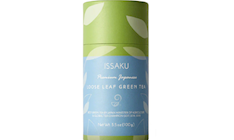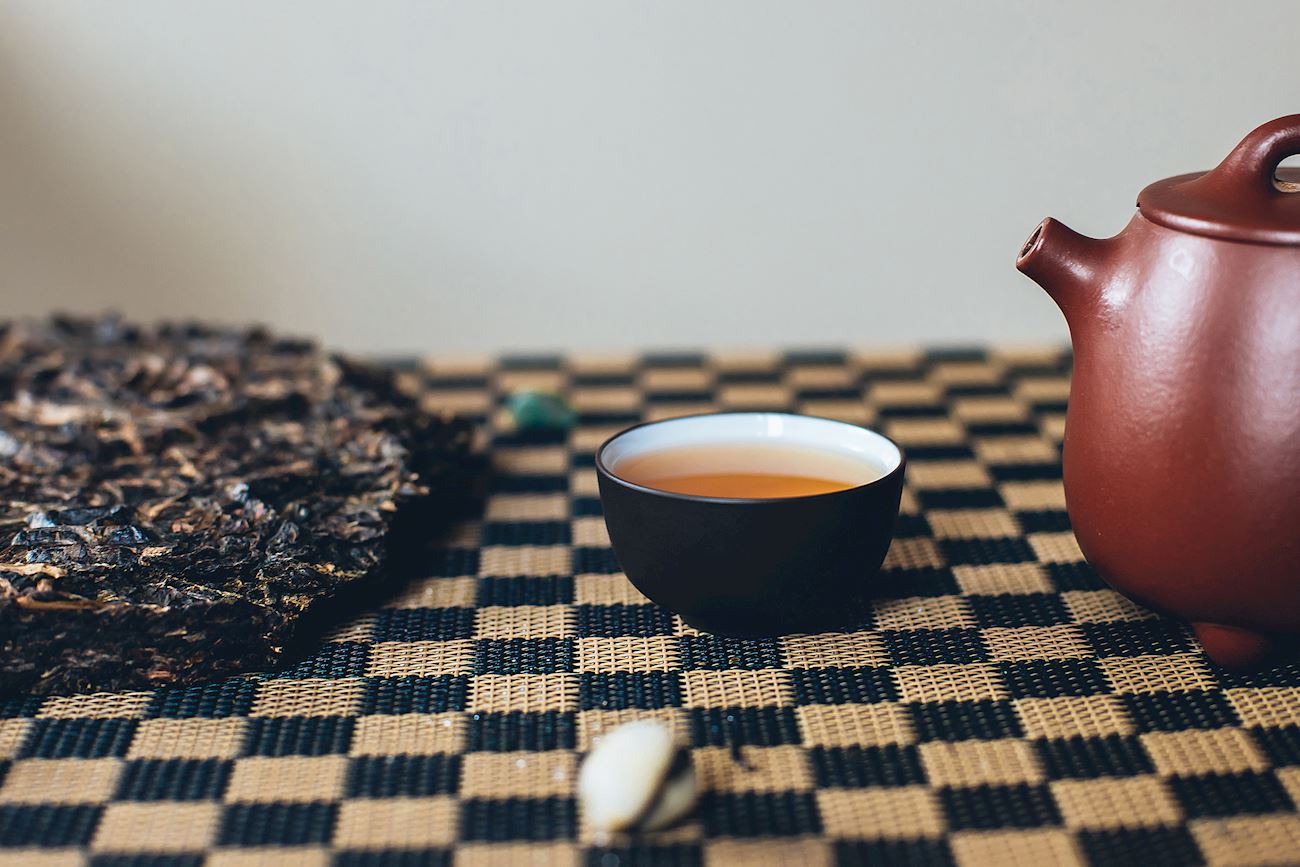TABLE OF CONTENTS
Best Chinese Tea Types
Longjing tea, literally translated to dragon well, is one of the best and most popular Chinese teas. It is a type of pan-roasted green tea. After roasting, the leaves should be emerald-colored, broad, flat, smooth, and brittle.
When brewed, this tea will produce a green-gold brew with a refreshing flavor and mellow vegetal aromas that often include buttery, toasty, nutty, and chestnut-like nuances. High-quality Longjing is usually harvested in spring, while summer harvest mostly produces low-quality versions.
Because of its high-quality and limited availability, the first pickings of authentic Longjing can reach astronomical prices and sell for up to $875 per kilo.
Sheng is the so-called raw variety of pu erh tea that is considered as the authentic and the original version of this highly-sought tea variety. Pu erh is made in Yunnan, but unlike shou that is artificially fermented, sheng is allowed to naturally age and ferment, often over the course of several years.
The aging process improves the overall characteristics of the tea—making it less astringent and mellow. The production process is simple, and after the tea is withered and sun-dried, it is usually pressed into blocks. It is then stored at a cool and preferably humid place.
Pu erh, also known as aged or vintage tea is a renowned tea produced exclusively in the Yunnan province of China. There are two main varieties: raw, non-fermented pu erh, called pu erh sheng, and ripe, fermented pu erh, known as pu erh shu.
The raw version has a very fresh, vegetal flavor with hints of bitterness and a sweet aftertaste, while the ripe one has a mild, yet distinctive and earthy flavor achieved by the fermentation process. For both varieties, the leaves can be left loose or compressed into brick tea (Juan Cha), cake tea (Beeng Cha), bell-shaped tea (Toa Cha), or mushroom-shaped tea (Maw Gu Toaw).
VARIATIONS OF Pu erh
THE BEST Pu erh Teas
Black tea is a large and diverse category, and what differentiates it from other tea varieties is heavy oxidation—in the process, the tea leaves of the Camellia sinensis plant attain their distinctive dark color and develop earthy notes.
When brewed, black tea will usually have a typical amber or brownish hue and stronger flavors and aromas, which may range from savory to sweet and include typical earthy, malty, nutty, and fruity nuances. However, since there are numerous variations and blends available, the final taste profile may significantly vary.
VARIATIONS OF Hong cha
THE BEST Hong cha Teas

Oolong is a semi-oxidized tea that can vary depending on the leaf style, level of oxidation, color, and the roasting degree. Falling somewhere between green and black teas, it is one of the most complex varieties regarding production, and it can take on a wide variety of flavors and aromas.
Their color can vary from pale green or yellow to dark orange, while the aromas often include notes of melons, apricots, wood, orchids, or spices. The level of oxidation can vary anywhere from 10-80%. The less oxidized styles resemble green teas, while more oxidized varieties, typically over 50% percent, share more characteristics with black teas.
VARIATIONS OF Oolong
THE BEST Oolong Teas
Shou is the artificially fermented sub-variety of pu erh tea. It is produced when raw pu erh (mao cha) is aged under specific temperature and humidity so that the fermentation can be accelerated and completed within two or three months.
The technique was developed in the 1970s, initially as a way to imitate the qualities of naturally fermented pu erh. However, the variety became so popular it evolved into a separate style. This pu-erh is smooth and it usually has an earthy, strong, and rich flavor.
Russian Caravan is a tea blend that is typically made with Chinese oolong and black teas. The blends may vary, but it mostly consists of at least two tea types, while the most common combinations include Keemun black tea, the smoky Lapsang Souchong, and oolong teas.
Although the exact selection may vary, Russian Caravan is based on fully or partially oxidized teas, and the final character is typically dark, smoky, spicy, and malty. Traditionally, Chinese black teas were used in the blend, but as there are no set ingredients, the variations may include Indian (Assam) or Taiwanese teas.
Green tea is a non-oxidized tea that is characterized by its bright green color and fresh herbaceous notes. It is produced with the tea leaves of the evergreen tea shrub (Camellia sinensis) that are involved in a process known as kill green—in which the leaves are heated (by steaming or pan-frying) to stop oxidation.
Nowadays, several varieties of green tea are available. They may differ in cultivation, harvesting, origin, and the technique used in their production. Green tea is also commonly flavored or used in blends. Because of the large number of available varieties, the final flavor profile of green tea can differ, but it typically has fresh, vegetal, grassy, and floral nuances.
VARIATIONS OF Lu cha
THE BEST Lu cha Teas

Matcha is a Chinese green tea variety that is unique for its harvesting, processing, and preparation methods. Three or four weeks before the harvest, the bush (Camellia sinensis) is covered to prevent direct sunlight, allowing the leaves to grow in the shade.
After the harvest, the leaves are cleaned from stems and veins and are then processed into a fine powder. Unlike most tea varieties, matcha always comes in a powdered form—the practice was first introduced in China, but it remained a standard in Japan.
THE BEST Matcha Teas
White tea is a category of Chinese tea that has a somewhat vague classification. Still, it is generally considered that this variety is lighter in color and has a more delicate flavor than green or black tea varieties. Although there are several variations, white tea is harvested from the tea plant (Camellia sinensis) when the tea leaves are not fully opened, and the buds are covered in tender white hairs—a trait that gave the tea its name.
Usually, white tea is non-oxidized, or it is just lightly oxidized, which helps to preserve its delicate character. When brewed, the tea is usually subtly sweet with a light straw color and subtle aromas and flavors that are often reminiscent of flowers, fruit, honey, vanilla, herbs, or citrus fruit.
VARIATIONS OF Bai cha
THE BEST Bai cha Teas
TABLE OF CONTENTS
Best Chinese Tea Producers
Gaopeng Tea Factory is a renowned producer of Wuyi rock teas (Yancha), located in the Zheng Yan region of Wuyi Mountain, China. The factory specializes in traditional charcoal-roasted teas, such as Huiyuan Pit Rougui and Dolomite Floral Shui Xian, known for their rich flavors and mineral complexity.
Their teas undergo meticulous processing, including multiple rounds of roasting, to enhance their aromatic depth and smooth mouthfeel. Gaopeng is highly regarded for preserving the heritage of Wuyi tea craftsmanship, ensuring high-quality production.
BEST Gaopeng Tea Factory Teas and Herbal Infusions
Zhang Yiyuan Tea is one of the most prestigious and time-honored tea brands in Beijing, China, with a rich history that dates back over a century. Founded in 1900, the brand has been providing high-quality traditional Chinese tea, and it is especially renowned for its green tea varieties, particularly Longjing tea, which is among the finest and most famous teas in China.
Over the years, Zhang Yiyuan has become an essential part of Beijing’s cultural and culinary heritage. The brand is well-known for offering a variety of premium teas, including green, black, and jasmine teas, as well as providing tea accessories and offering traditional tea ceremonies to both locals and visitors alike.
BEST Zhang Yiyuan Tea Teas and Herbal Infusions
Beyond Bubble (Shanghai) Food Technology Co., Ltd. was established in 2021 and owns the cutting-edge juice sparkling water brand "Beyond Bubble". "Beyond Bubble" uses high-temperature extracted liquid bubble tea. Its main product is added with self-developed citrus essence and ginger juice.
It does not contain sucrose and fat. The current products include jasmine citrus flavor, ginger lemon flavor, grape oolong flavor, and white peach oolong flavor.
AWARDS

Crystal Taste Award - 3 stars
2024
TeaVivre is a producer specializing in Chinese teas, including a wide range of green teas. They source their teas directly from farms in various Chinese regions such as Zhejiang and Anhui. The company emphasizes quality control and offers detailed information about the origin and production methods of their teas.
Their offerings include both organic and non-organic teas. TeaVivre also focuses on environmentally friendly practices in their packaging. They provide extensive tasting notes and brewing instructions for each tea variety they sell.
AWARDS

Great Taste Awards - 2 stars
2024

Great Taste Awards - 3 stars
2022
BEST TeaVivre Teas and Herbal Infusions
TABLE OF CONTENTS
Best Chinese Teas
Huiyuan Pit Rougui by Gaopeng Tea Factory is a premium Wuyi rock tea sourced from the Huiyuan Pit, a renowned micro-region within the Zheng Yan core area of Wuyi Mountain, China. This tea is known for its rich cinnamon (Rougui) aroma, deep mineral complexity (Yan Yun or "rock rhyme"), and a balance of sweetness, spice, and floral notes.
It undergoes traditional charcoal roasting, enhancing its smooth, full-bodied texture and long-lasting aftertaste, making it a sought-after selection among high-end Wuyi teas.
Zhang Yi Yuan Premium Jasmine Green Tea is a high-quality tea product offered by Zhang Yiyuan, one of the most renowned tea brands in China. This premium jasmine green tea is carefully selected and blended with fragrant jasmine flowers, known for its soothing and aromatic profile.
The tea offers a delicate balance of the fresh, crisp taste of green tea, with the sweet floral fragrance of jasmine, making it a perfect choice for tea lovers who enjoy aromatic teas. Zhang Yi Yuan is famous for its long-standing tradition of high-quality tea production, and this jasmine green tea is no exception.
AWARDS

Great Taste Awards - 2 stars
2024
Lu Shan Yun Wu Green Tea, made by TeaVivre Tea Company, is a premium green tea known for its unique flavor and fragrance. The tea leaves are carefully harvested from the misty slopes of Mount Lu in Jiangxi Province, China. This tea is praised for its delicate, sweet, and slightly vegetal taste, which is complemented by a pleasingly gentle aroma.
The infusion typically yields a light green liquor that is both refreshing and invigorating.
AWARDS

Great Taste Awards - 3 stars
2022
TasteAtlas food rankings are based on the ratings of the TasteAtlas audience, with a series of mechanisms that recognize real users and that ignore bot, nationalist or local patriotic ratings, and give additional value to the ratings of users that the system recognizes as knowledgeable. For the “Top 24 Chinese Teas” list until April 24, 2025, 1,286 ratings were recorded, of which 1,190 were recognized by the system as legitimate. TasteAtlas Rankings should not be seen as the final global conclusion about food. Their purpose is to promote excellent local foods, instill pride in traditional dishes, and arouse curiosity about dishes you haven’t tried.





















































